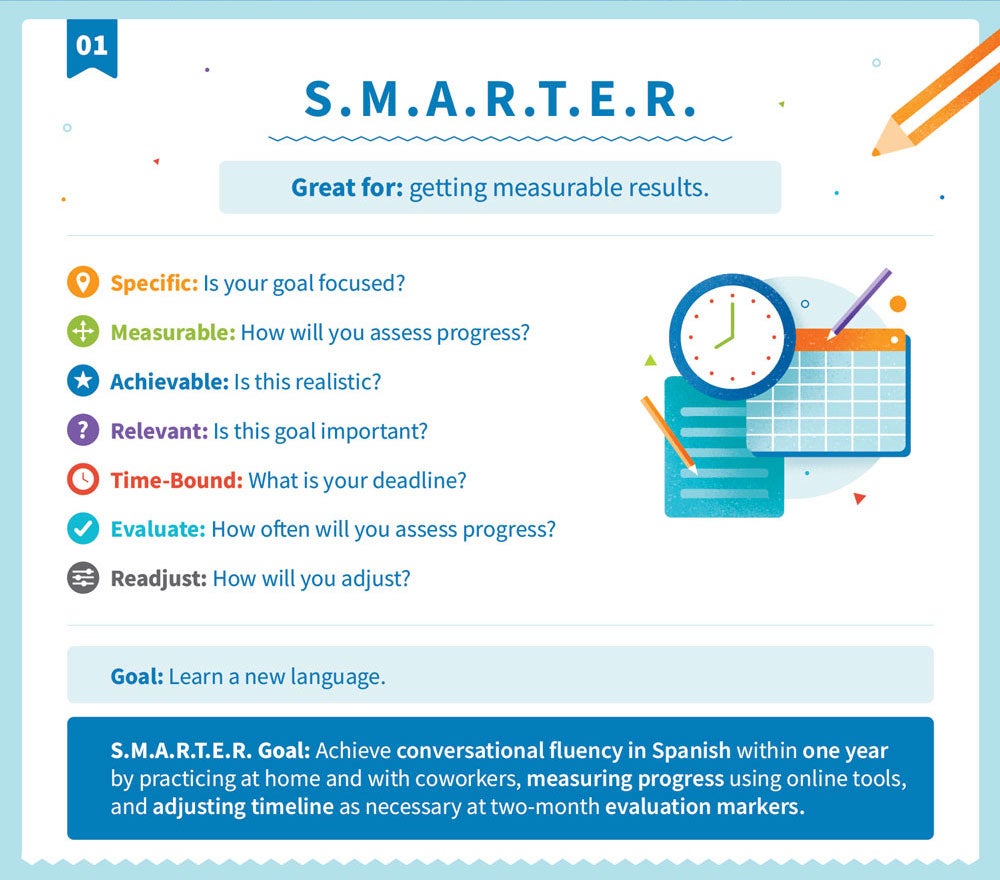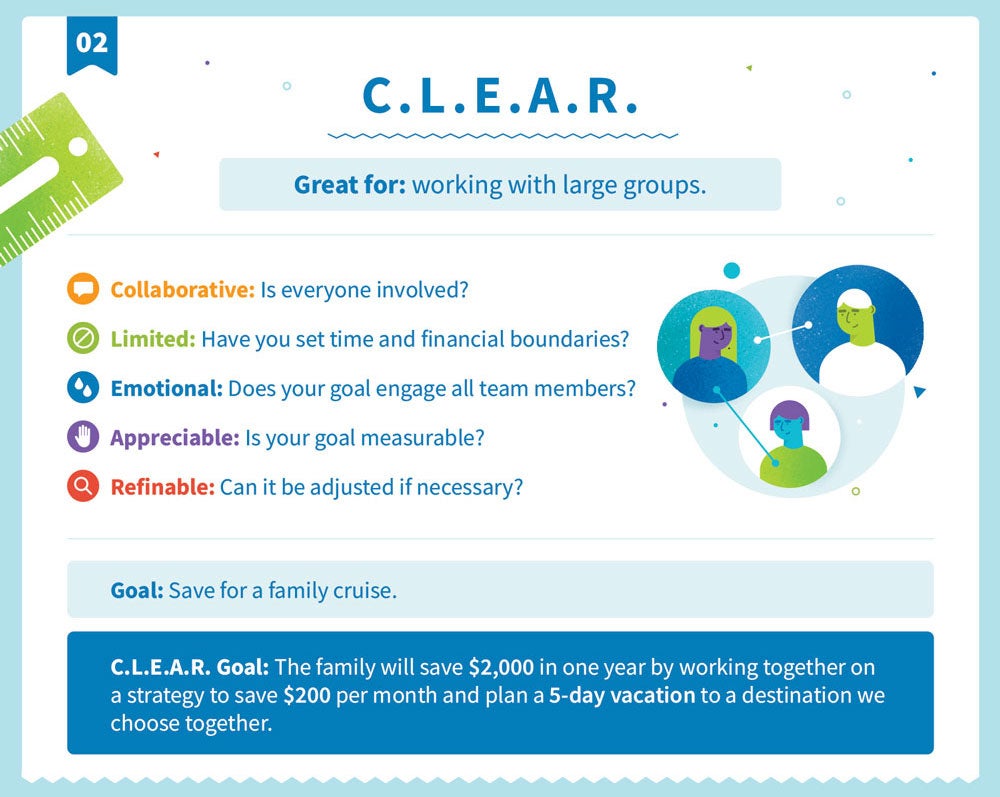
Goal-setting is a key practice in just about every field, both personal and professional. That said, just because most people set goals doesn’t mean each person is capable of achieving them. In fact, most aren’t — one study by researchers at the University of Scranton found that of 200 people who made New Year’s resolutions, only 19 percent managed to maintain their commitments for two years.
Whether you’re saving up for the down payment on your dream home or just trying to get a handle on your personal finances, your likelihood of success skyrockets the moment you start using a written, structured goal-setting strategy.
Productivity experts have studied the characteristics that make up a well-written goal and compressed them into an acronym: SMART, which stands for specific, measurable, achievable, relevant and time-bound.
But though using the SMART model produces higher-quality goals than using no model at all, it does contain plenty of flaws and isn’t applicable everywhere. As a result, a wide array of adaptations and alternatives have sprung up across the productivity space, each specific to a problem and offering unique advantages.
Below we’ve outlined nine of the most popular alternatives to SMART goals.
Table of Contents:
- S.M.A.R.T.E.R. Goals
- C.L.E.A.R. Goals
- D.U.M.B. Goals
- H.A.R.D. Goals
- W.I.S.E. Goals
- F.A.S.T. Goals
- G.R.O.W. Goals
- O.K.R.s
- K.P.I.s
Or you can jump to the full infographic.
1. S.M.A.R.T.E.R.
One of SMART’s major weaknesses is that it lacks in-progress assessment, which makes it difficult to adapt as you encounter obstacles, receive new information and alter the pace of progress toward your goal.
Research shows that goals are much more achievable when opportunities for feedback are involved. Having expectations laid out pushes the individual to meet them and maintain the pace needed.
The SMARTER model consists of the original five SMART stages plus two new letters.
Evaluate
In this stage, one would assess their progress by checking it against the original plan. This is a habit that most successful goal-setters practice. It encourages sustained commitment to the objective and helps the individual focus their energy and methods more effectively.
Ask yourself: How often should I revisit my goal? How will I measure my progress? What factors should I evaluate and when?
Readjust
In order to keep moving in the direction of the goal, it’s essential that the original plan be flexible enough to adjust. A lot can change along the way, and without a plan B, an unexpected obstacle could result in failure.
Ask yourself: How will I adjust to account for obstacles or breakthroughs? Which factors can be easily tweaked and which are more rigid? What external deadlines do I have and how can I adjust them?

Setting SMARTER Goals
Traditional Goal
Save $5,000 by the end of the year by setting aside $200 of every paycheck in a savings account.
SMARTER Goal
Save $5,000 by the end of the year by setting aside an average of $400 per month, revisiting monthly and adjusting budgets to account for months where savings must be higher or lower.
2. C.L.E.A.R.
One of SMART’s main strengths is its laser focus on a specific path, but when working with a group, specificity can become a stumbling block. That’s where CLEAR comes in, forcing the goal-writer to consider the impact of a team dynamic on their goal’s success from the very first step.
Collaborative
Write goals that drive your team’s momentum and incentivize the group as a whole to reach their target.
Ask yourself: Who’s on my team? Which non-team members will be involved? Who do I need to help me? How will these people’s personalities, strengths and weaknesses impact our progress?
Limited
Set clear boundaries with respect to time, geography, and resources.
Ask yourself: When will my goal process start and end? What units of measure will I use to evaluate your progress? What resources and budget do I have?
Emotional
Group goals must have an emotional element in order to engage the people on your team who may not feel as confident or important. Getting them invested will give them a higher sense of obligation while working toward your shared success.
Ask yourself: What is the driving motivator? Why should people on my team care about our goal? Why should people outside my team care about our goal? How will our progress impact us and others?
Appreciable
It’s essential to make sure up front that your team will be able to break your goal down into measurable chunks.
Ask: What milestones can I set along the path of progress to our goal? What performance metrics can I use to ensure everyone is measuring their progress in the same way?
Refinable
Make sure your goal can be adjusted as you go along. When new situations and information arise, if your original goal can’t be refined to account for that, it will quickly fall out of date.
Ask yourself: What information can I anticipate changing? How can our goal bend to accommodate those changes? What parts of our goal are essential and what parts can change?

Setting CLEAR Goals
Traditional Goal
Save $5,000 to take a family cruise next year by downgrading household services, lowering utility bills, cutting back on transportation costs and renegotiating cable contract.
C.L.E.A.R. Goal
Save $5,000 for a vacation to a destination that the family chooses by working together to set money-saving goals that everyone can contribute to, like using less energy, having fewer restaurant meals, carpooling with friends and opting for free activities on weekends.
3. D.U.M.B.
DUMB goals are designed to do the opposite of traditional goal-setting models by pushing the boundaries of the goal-setter’s imagination and encourage them to reach for the outer boundaries of their capabilities.
Dream-driven
While it may be the best way to keep your goals attainable, hyper-realism can kill creativity, keep you in your comfort zone and dull your inspiration.
Ask yourself: What are my desires? How can I get out of my comfort zone?
Uplifting
Research has shown that attitudes of hope and optimism are directly tied to higher-grade performance among college students. Similarly, personal goals that are written with a positive attitude are more likely to come to fruition.
Ask yourself: Is this goal worded in a positive, optimistic way? If my goal is tied directly to a stressful topic, is there another, more positive motivator I can tie to it?
Method-friendly
Tie your ultimate dream to a tangible process so you can better understand how to get started.
Ask yourself: What can I do today that will move me toward my goal? What practices can I put in place that will help me make consistent progress daily, weekly, monthly and yearly?
Behavior-driven
This step is about coming up with behavioral triggers that will keep you advancing toward your goal even when you don’t feel like working on it.
Ask yourself: What habits do I already have and how can I repurpose them in service of my goal? What automatic behaviors can I practice that will make working toward my goal feel instinctual?
Setting DUMB Goals
Traditional Goal
Open a retirement savings account and make regular contributions in order to retire at 65.
D.U.M.B. Goal
Develop daily savings habits and contribute every spare penny to a retirement account in order to become financially independent within the next 10 years and achieve lifelong dream of traveling around the world.
4. H.A.R.D.
Like DUMB goals, HARD goals are designed to solve for the fact that SMART goals are sometimes so achievable and realistic that they become boring and unchallenging.
HARD goals energize the goal-setter, encouraging them to pursue difficult, audacious goals that challenge them as a person.
Heartfelt
Aiming for a target because you feel obligated to isn’t the same as having a goal you really, truly desire for yourself. If your goal isn’t something you connect with emotionally, consider pushing yourself to aim for something you care about more.
Ask yourself: Is my goal heartfelt? If I’ve set a goal of getting a promotion and a raise, am I inspired by the work I would be doing in that role or am I simply going through the motions that I feel are expected?
Animated
It’s not enough to set a goal — you need to be able to picture yourself, in detail, achieving that goal. Ensuring you have animated goals will help you make sure you’re aiming for what you actually want.
Ask yourself: Can I see myself in my new day-to-day? How will my life look different?
Required
If you can’t identify the required steps needed to reach your target, you may not be choosing something heartfelt or animated enough. Get specific and engage with your goals — you’ll find it easier to see what the first steps toward it should be.
Ask: What must I do today, this week, this month or this year?
Difficult
Research actually shows a correlation between a goal’s difficulty and the goal-setter’s likelihood of success.
Ask yourself: Will my goal require significant work to achieve? Is my goal ambitious?
Setting HARD Goals
Traditional Goal
Pay off student loans by making minimum payments on time every month.
H.A.R.D. Goal
Increase monthly loan payments to pay off student debt within 10 years so I can start saving for my kids’ college fund and help them avoid taking out loans of their own.
5. W.I.S.E.
WISE goals are designed to address a number of shortcomings of the SMART system.
The WISE framework asks the writer to consider all aspects of their goal in a holistic way, examining and planning for the ways in which your goal journey will interact with other goals, other people and other areas of your life.
Written
As with all goals, WISE goals must be written down. Simply using the acronym as a mental checklist isn’t enough to increase the likelihood of success. No matter how clear you believe your mental goal-setting process is, writing it down in words forces you to be exact.
Integrated
It’s important to look at your goals within the larger context — by integrating your goals, you improve your likelihood for success since you maintained a realistic viewpoint from the beginning of your planning stages.
Synergistic
If you have two goals whose demands are impossible to sustain at once, you need to integrate them, assess your priorities and decide where you’re willing to make changes in order to be able to pursue both goals at once.
Expansive
The WISE model encourages goal-setters to push the boundaries of their goals beyond the realm of what’s comfortable or safe.
Setting WISE Goals
Traditional Goals
Cut back on spending in order to save up and open an investment account with two percent or higher ROI by the end of the year.
W.I.S.E. Goal
Save up and prioritize paying off high-interest credit card accounts within six months,
then capitalize on new saving habits to put toward opening an investment account while
maintaining good credit health.
6. F.A.S.T.
The FAST framework is a goal-setting model that stands for frequently discussed, ambitious, specific and transparent. It’s used to help employees set professional career goals and team performance targets. Unlike other goal models, FAST helps individuals and teams integrate their respective goals, by encouraging team members to share their progress with others.
FAST goals help employers encourage teams to set clear shared goals in addition to individuals’ personal ones.
Frequently Discussed
Not only does FAST allow for goals to be updated and refined — it requires it. This keeps the goal-setter focused and creates a structure for correcting and improving processes.
Ambitious
While SMART goals tend to be conservative and DUMB goals are designed to be extravagant, FAST goals fall right in the middle. They should be difficult and high-reaching, but not impossible to achieve.
Specific
Though FAST goals are meant to be an upgrade from SMART goals, they still must be specific, measurable and time-bound. Don’t cut corners on this step. Psychologists have determined that low-quality or vague plans can predict negative outcomes in pursuit of a goal.
Transparent
If you’re setting goals within a team, all members should have access to each others’ goals. Social comparison has been proven to increase successful goal achievement.
Transparency between teams also helps individuals contextualize their progress within a larger system and paves the way for unhindered communication throughout the project.
Setting FAST Goals
Traditional Goal
Spend less money at restaurants and bars.
F.A.S.T. Goal
Work with roommates to develop a plan that includes cooking at home more often and choosing cheaper weekend activities. Revisit the strategy each week while planning the upcoming week’s groceries and social plans.
7. G.R.O.W.
GROW stands for goal, reality, obstacle and will. It encourages the individual to anticipate and prepare for potential roadblocks that could knock them off their path, increasing the likelihood that they’ll succeed.
Goal
The first step of GROW is easy: set a goal. This model is best-suited for people who are experienced goal-setters and can write a reasonably specific, well-scoped goal without much guidance.
Ask yourself: Is my goal specific, measurable, time-bound, achievable and realistic?
Reality
This step asks the individual to assess where they currently are as it relates to where they want to go.
Ask yourself: How far am I from my goal? What resources, skills and capabilities do I currently have? What new skill sets do I need to acquire to achieve my goal?
Obstacles
Next, GROW asks the individual to evaluate the path ahead, identifying existing and potential obstacles in their way.
Ask yourself: What roadblocks currently exist between me and my goal? What additional problems could occur? How can I overcome these problems?
Will
Through the first three steps, the individual defines what their goal is and how they plan to get there. In this step, they establish why.
Ask yourself: What is driving me to pursue this objective? Clearly defining your motivation ahead of time will make it easier to remember your purpose you encounter obstacles and challenges.
Setting GROW Goals
Traditional Goal
Get a raise at work.
G.R.O.W. Goal
Get promotion and $10,000 raise within the next three months. Think through your path: if you’ve met the required performance metrics for three consecutive fiscal quarters, you should be able to ask for a promotion after successfully coordinating the annual sales conference and increasing attendance by at least 10%. Potential obstacles include conference planning committee members not following through and low RSVP rates, which you can account for by building in extra planning time to double check all work and send out extra invitations. Your motivation can be a vacation you will take with your partner after your promotion.
Though the goal portion of the GROW goal is essentially the same as a SMART goal, the GROW structure allows the goal-setter to more easily anticipate problems. By planning for these obstacles, the goal-setter can maintain motivation throughout the project, decreasing the likelihood that these obstacles derail their project.
8. O.K.R.s
This stands for objective and key results. While SMART encourages the individual to be more granular in their goal, the OKR model has the goal-setter maintain a broader target.
Objective
Your objective should be to reach a general end result. It should be large enough that it can encompass multiple smaller aims underneath it and will not fall out-of-date if circumstances change.
Ask yourself: What are the essential factors of my ultimate goal? Will this goal change if my progress runs off-schedule, budgets change or obstacles arrive? Will this objective still be relevant as my team, industry or environment innovates?
Key Results
These are focused and exact sub-objectives. They are short-term and can be replaced or updated to keep up with changing environments.
Ask: Are my key results specific, measurable and time-bound? Do they serve the larger objective? Can I complete them quickly enough that they will not become obsolete while I am working toward them?
Setting OKRs
Traditional Goal
Continue to grow and existing savings account.
OKR Goal
Grow an existing savings account by five percent over the next 12 months.
Key Results:
- Move funds out of savings and into a high-interest account
- Increase the portion of monthly savings from your paycheck by five percent
- Identify overspending patterns and cut non-essential expenses by 15-20 percent for the year
9. K.P.I.
K.P.I. stands for key performance indicators and is how a goal-setter can determine whether or not their efforts are actually effective.
Your KPIs should help you track your journey, from your current state to your ultimate goal. Use them to break down your overall goal into more easily measurable sub-goals, making your final objective more manageable.
Ask yourself: What performance indicators can I use to measure how well I’m sticking to my behavioral commitments?
Setting KPIs
Traditional Goal
Improve credit score by 200 points.
KPIs
Improve credit by setting and hitting key goal measurements, like consecutive months paid in full, percent utilization ratio and balance carried month-to-month.
How to Choose the Right Goal Model for You
Figuring out which goal-setting model will work for you doesn’t need to be overwhelming. Consider your own needs, the scope of your project and the bandwidth of your team before deciding which structure suits you best. Ask yourself:
- Am I an individual or a team?
- How much flexibility do I need?
- How strict do I need my structure to be?
- How quickly does my environment evolve?
- How quickly do my goals need to adapt?
- Do I want to be more ambitious, or should I be more realistic?
As you find the answers to these questions, you should begin to see which goal-setting structure is the right choice. If you find yourself caught between two choices, combine them. A hybrid goal model may make more sense for your project and goals.

No matter which goal model you choose, having a goal structure of some sort — one that is clear, defined and written down on paper — will help you achieve your objectives. If you’ve tried out these tips and still struggle to make progress on your goals, you could also consult with a professional.
Whether it’s a personal trainer to help with your fitness or a credit repair specialist to help you manage your debt, remember that you don’t have to do this alone. An expert can help you set and define your goals, and then assist you in maintaining that commitment over time. With a good structure and solid support, any goal is achievable.






